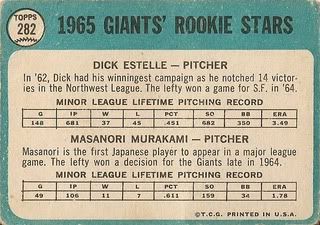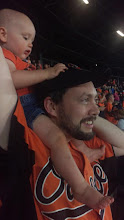
Fun facts about Dick Estelle:
-A native of Lakewood, NJ, Dick signed with the Giants at age 18 in 1960.
-In 1964, he struck out 167 batters in 152 innings at AAA Tacoma to earn a September callup to San Francisco.
-After taking a hard-luck loss while pitching into the tenth inning in his second start, Dick earned his first career win on September 22, 1964 with eight innings of one-run ball against Houston. Incidentally, Murakami earned his first career save by relieving the starter in the ninth and stranding two inherited runners.
-In 41.2 innings in 1964, Estelle went 1-2 with a 3.02 ERA. He struck out 23 and walked 23.
-After returning to AAA in 1965, he earned another look in September. Making 5 relief appearances and a start, he allowed 6 runs (5 earned) in 11.1 innings for a 3.97 ERA.
-Dick never pitched again in the big leagues. He stayed active in the minors through the 1972 season, finishing with a 102-123 record and a 3.67 ERA in parts of 13 minor league seasons.
-His career big league record was 1-2 with a 3.23 ERA.
-Estelle was inducted into the Lakewood High School Hall of Fame in 2006. In his senior year, he had gone 11-2 with an 0.38 ERA.
Fun facts about Masanori Murakami:
-Masanori was born in Otsuki, Japan. His father wanted him to become a doctor, and only permitted him to play baseball if he agreed to continue studying diligently. He appeared briefly for the Nankai Hawks in 1963 before being sent to the Giants as part of a development deal between the two clubs.
-Working out of the bullpen at Class A Fresno, Murakami appeared in 49 games in 1964, going 11-7 with an excellent 1.78 ERA and 0.93 WHIP. The Giants promoted him to the big leagues in September.
-The 20-year-old became the first Japanese player in the major leagues and endeared himself quickly to fans and teammates, bowing to his fielders when they made good plays behind him. He strung together eight scoreless appearances to begin his career. He picked up the aforementioned save in Dick Estelle's only career win, and added a win of his own with three innings of one-hit relief against Houston on September 29. He allowed his only 3 runs in his final appearance on the year, finishing with a 1.80 ERA in 15 innings.
-Though the Giants expected to have his services again in 1965, the Hawks insisted that he had only been loaned to the American club and the two teams and their respective leagues engaged in a war of words. An agreement was finally brokered that allowed Murakami to return to San Francisco in early May.
-Masanori pitched reasonably well in 45 games, going 4-1 with 5 holds, 8 saves, and a 3.75 ERA. The Giants won 95 games and finished just 2 back of the first-place Dodgers.
-At the insistence of his father, he returned to Japan and the Hawks in 1966. He struggled under high expectations and was criticized for supposed bad "American" habits. He pitched in Japan through the 1982 season, finishing his career with a 103-82 record (largely on the strength of an 18-4, 2.38 ERA season in 1968) and a 3.64 ERA.
-He attended spring training with the San Francisco Giants in 1983, but did not make the team at age 38 and chose to go back to Japan. This left his major league record at 5-1 with 9 saves and a 3.43 ERA.
-Masanori later broadcast games for the Japanese NHK network.



Thanks for the great Murakami facts... that rookie card was one of my first purchases when I came back into the hobby scene 10+ years ago.
ReplyDeleteWhile it sounds good he was called up from AAA Fresno at the age of 20, its even more impressive that he was called up from Class A Fresno, California League ... :)
ReplyDeleteI first heard of and learned a little about Murakami during the 1983 Spring training. If he would have made it would have been 18 year span between MLB appearences, I can't think of anyone with a longer span (even minny minoso played in a games only 14 years apart). Misus the psycho girl with a gun, it span of time worthy of the Natural.
ReplyDeleteI like seeing the cards of these guys that barely played in the major leagues. I can imagine them going home after their time in baseball was up, getting a job and then being able to tell their friends about playing in the big leagues. Sort of like Moonlight Graham in "Field of Dreams."
ReplyDeleteFuji - You're welcome!
ReplyDeleteMike - Yikes! Thanks for catching my goof.
Anon - I can't think of anyone with a longer gap either.
Marc - These cards are great for completists. It goes without saying that some of these guys didn't make it to cardboard otherwise.
I thought Satchell Paige had him beat, but he only had a 12-year gap before returning to the majors in 1965, and a 16-year gap if you don't count the Browns as a major-league team ;)
ReplyDeleteBetween Masanori Murakami and the spooky air-brushed world of Dick Estelle, this card seemed very exotic to a 7-year-old. Air-brushed photos in newspapers and magazines gave me the creeps, as did the old newspaper practice of blurring photos of the deceased.
ReplyDeleteD.E. is my best friend ,from childhood,father..ultra cool , nice man - great family man and awesome ..... He never bragged or boasted and I never knew he was in baseball until I was an adult- very cool.
ReplyDelete